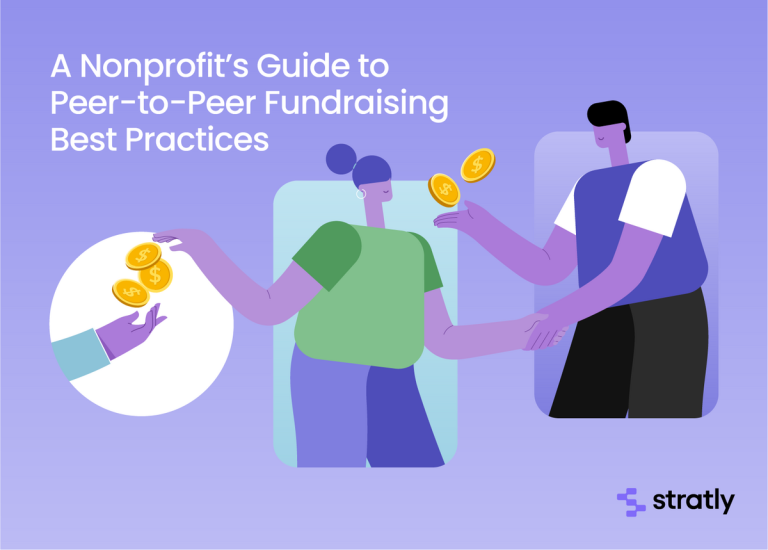Peer-to-peer fundraising has transformed how nonprofits and charities raise funds. This powerful strategy harnesses supporters’ networks and passion to attract new donors and amplify fundraising efforts. But, if you’re not using peer-to-peer fundraising best practices, your efforts may not be successful.
For that reason, today that’s exactly what we’re sharing – peer-to-peer fundraising best practices that will take your organization’s strategy from good to great, whether you’re a seasoned fundraiser or just starting. These insights will help you maximize your impact and achieve your fundraising goals.
We’re going to cover:
- Understanding Peer-to-Peer Fundraising
- Set Clear Goals and Expectations
- Empower Your Fundraisers
- Leverage Technology for Success
- Create Compelling Campaign Narratives
- Incentivize and Recognize Fundraisers
- Engage Throughout the Campaign
- Follow Up and Show Impact
- Learn and Iterate
Understanding Peer-to-Peer Fundraising
Before diving into best practices, it’s important to grasp the essence of peer-to-peer fundraising. Essentially, it’s a method where your supporters become fundraisers themselves, reaching out to their own personal networks to raise money on your behalf.
For example, when families sell candy or popcorn to friends, family, and colleagues for their kid’s sports teams, this is a form of peer-to-peer fundraising. Or when a friend posts a GoFundMe link for someone in need on their social accounts. All in that wheelhouse!
This approach utilizes personal connections and social proof.
When friends ask friends to support a cause, it holds more weight than an organization’s direct appeal. It’s essentially word-of-mouth marketing for your fundraising endeavors.
The Benefits of Peer-to-Peer Fundraising
Peer-to-peer fundraising offers numerous advantages:
- Expanded Reach: Access new donor pools through your supporters’ networks.
- Increased Engagement: Supporters feel more connected as active participants in your cause.
- Cost-Effective: It’s often less expensive than traditional marketing campaigns.
- Social Proof: Personal endorsements from friends are strong motivators for giving.
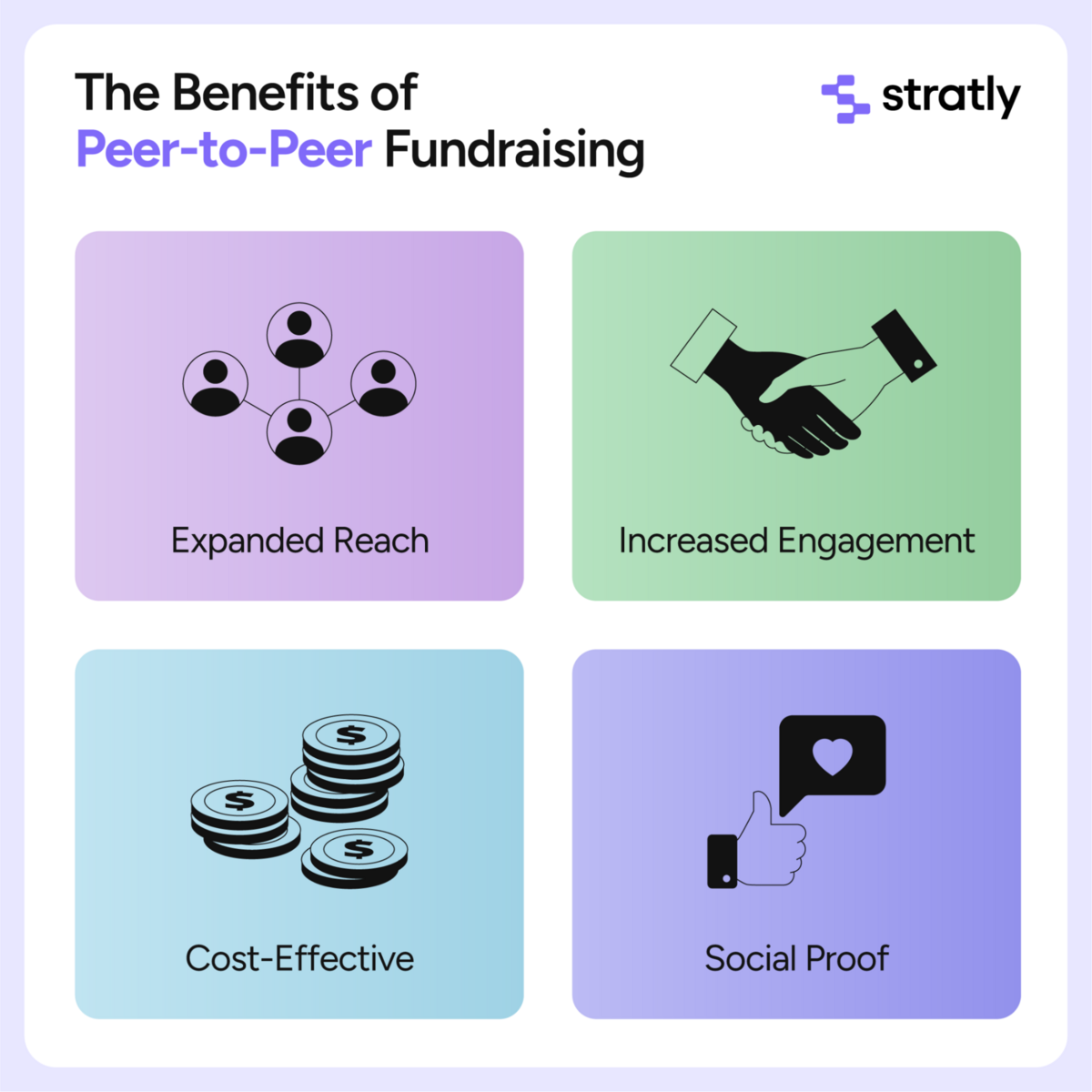
Now, let’s explore the best practices that will set you up for success.
Set Clear Goals and Expectations
The foundation of any successful peer-to-peer campaign is a set of clear, attainable goals. Without them, you’re navigating without direction.
Define Your Fundraising Target
Begin by establishing a realistic overall fundraising goal. This should consider factors like past campaign performance, your supporter base size, and the urgency of your cause.
Break this down into individual fundraising goals, making it manageable and motivating for your supporters.
Establish Campaign Timelines
Decide on the campaign’s duration. Shorter campaigns (4-6 weeks) often maintain momentum better. Meanwhile, longer campaigns might be necessary for more ambitious goals.
Whatever you decide, communicate these timelines to your volunteer fundraisers.
| Campaign Duration | Pros | Cons |
| Short (4-6 weeks) | Maintains urgency, easier to sustain momentum | Less time for fundraisers to hit their fundraising goals |
| Medium (2-3 months) | Balanced approach, allows for mid-campaign adjustments | Requires more consistent engagement |
| Long (3+ months) | More time to achieve larger goals, can coincide with events | Risk of campaign fatigue, harder to maintain excitement |
Empower Your Fundraisers
Your supporters are the driving force behind peer-to-peer fundraising. Providing them with the necessary tools and knowledge is crucial for success.
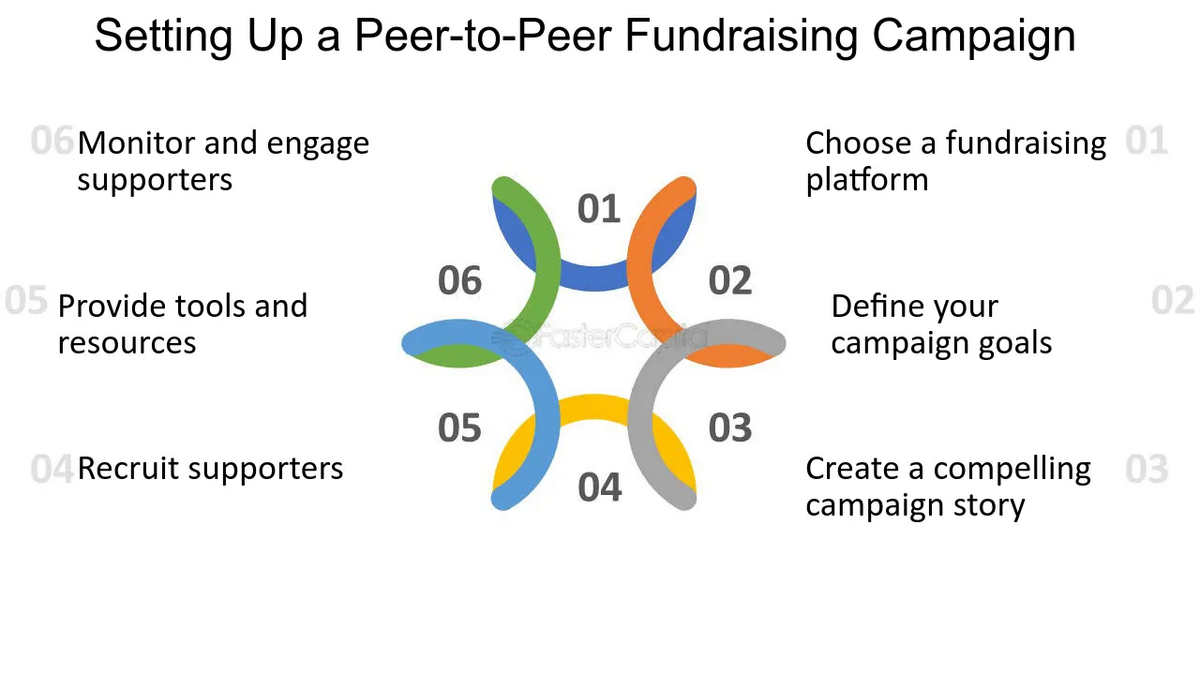
Provide Comprehensive Training
Don’t assume your fundraisers are experts at asking for donations. Offer training that covers:
- The art of storytelling
- Crafting a compelling ask
- Using social media for fundraising
- Overcoming common objections
The more you give your fundraisers, the more successful your peer-to-peer campaigns will be!
You can even go a step further and provide a fundraising toolkit with the following:
Campaign messaging and key talking points
- Social media post templates and graphics
- Email templates for various campaign stages
- An FAQ document to address common donor questions
By offering these resources, you set your fundraisers up for success and it also ensures consistent messaging throughout your campaign. A win-win!
Leverage Technology for Success
In today’s digital landscape, having the right technology is paramount for peer-to-peer fundraising efforts. Proper tools streamline processes, enhance donor experiences, and offer valuable insights.
Choose the Right Fundraising Platform
Choosing a user-friendly platform with robust features is vital. Look for platforms like Stratly that are offering:
- Easy-to-create fundraising pages and forms
- Seamless social media integration
- Mobile-responsive design
- Real-time donation tracking
- Secure payment processing
- Text-to-give options
You can find all of our peer-to-peer fundraising information here.
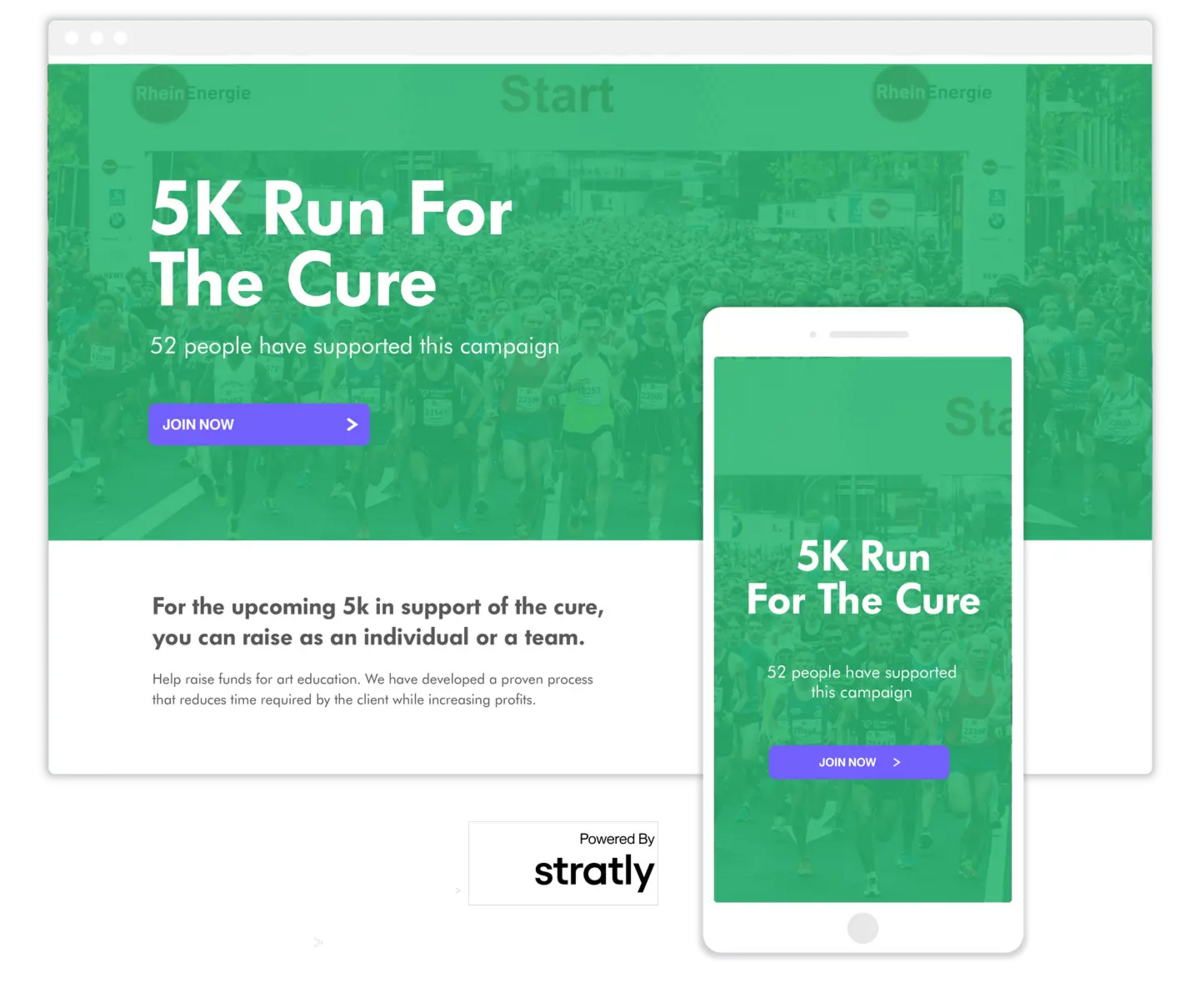
Utilize Data Analytics
Once you’ve leveraged an effective peer-to-peer fundraising platform, it’s time to put it to work with analytics. Data is invaluable in peer-to-peer fundraising. You should be using your data to:
- Track fundraiser performance
- Pinpoint top performers and areas for improvement
- Understand donor behavior and preferences
- Gauge the success of different communication approaches
By leveraging analytics, you can make data-driven choices and fine-tune your campaign as it progresses. The key to this is to choose peer-to-peer fundraising software that tracks exactly what you need to reach your team’s specific goals.
Create Compelling Campaign Narratives
Below are tips to create a strong narrative thread throughout your fundraising campaign.
Develop a Strong Central Narrative
Pulling at the heartstrings always gets more donations; we know this. So, spend time creating a powerful, overarching campaign story that:
- Clearly outlines the problem you aim to solve
- Demonstrates the tangible impact of donations
- Vividly portrays the positive change you are making
This central narrative should be adaptable for your fundraisers to personalize and share.
Then, ensure your fundraisers all know the storyline and can even add to it with their own experience while having fundraising conversations.
Encourage Personal Storytelling
On that note, not every donor or fundraiser is going to be able to tell their story easily, especially if it’s a sensitive topic. Help them along the way by offering prompts or templates to help them develop their narratives, such as:
- What initially drew you to our mission?
- What is your vision for the future if we reach our goal?
- How has our work impacted you or someone you know?
Authentic, heartfelt stories resonate deeply in peer-to-peer fundraising and with encouragement from your team, your donors will feel more comfortable and supported while sharing their own vulnerable experiences.
Incentivize and Recognize Fundraisers
Motivation is paramount, even if people are coming from a heart-centered place. Acknowledging and rewarding your fundraisers can uplift spirits and yield excellent results.
Implement a Tiered Reward System
Create incentives tied to different fundraising achievements. These could be:
- Branded merchandise for lower tiers
- Exclusive experiences or events for mid-tier achievers
- Public recognition or high-value rewards for top performers
Your rewards should reflect your organization’s values and appeal to your fundraisers.
Celebrate Successes Publicly
Use social media and email newsletters to spotlight fundraiser achievements. Not only does this encourage the individuals recognized, but it also inspires others.
Consider creating a leaderboard to cultivate healthy competition. Ensure you acknowledge effort and results to maintain everyone’s motivation.
Engage Throughout the Campaign
Sustaining momentum is crucial. Consistent engagement keeps your fundraisers inspired and donors invested. So, how do you do it?
Here are a few ways to keep on top of things:
Develop a Communication Calendar
Strategize a series of touchpoints throughout your campaign:
- A kickoff event or webinar to generate initial excitement
- Weekly email updates highlighting campaign progress and success stories
- Mid-campaign check-ins to tackle challenges and exchange fundraising tips
- Final push communications encouraging last-minute donations
Leverage Social Media Effectively
Social media is an invaluable tool. Use it to:
- Share real-time campaign progress
- Highlight fundraiser and donor experiences
- Host live Q&A sessions or offer behind-the-scenes glimpses
- Create engaging, shareable content for fundraisers
Utilize relevant hashtags and motivate your fundraisers to do the same for wider visibility.
Follow Up and Show Impact
The campaign’s end is merely the beginning of donor stewardship. A well-executed follow-up can convert one-time donors into dedicated, long-term supporters.
This follow-up can come from your team, and/or those who secured their donation. It depends on your goals, your campaign, and your fundraisers desires/ availability.
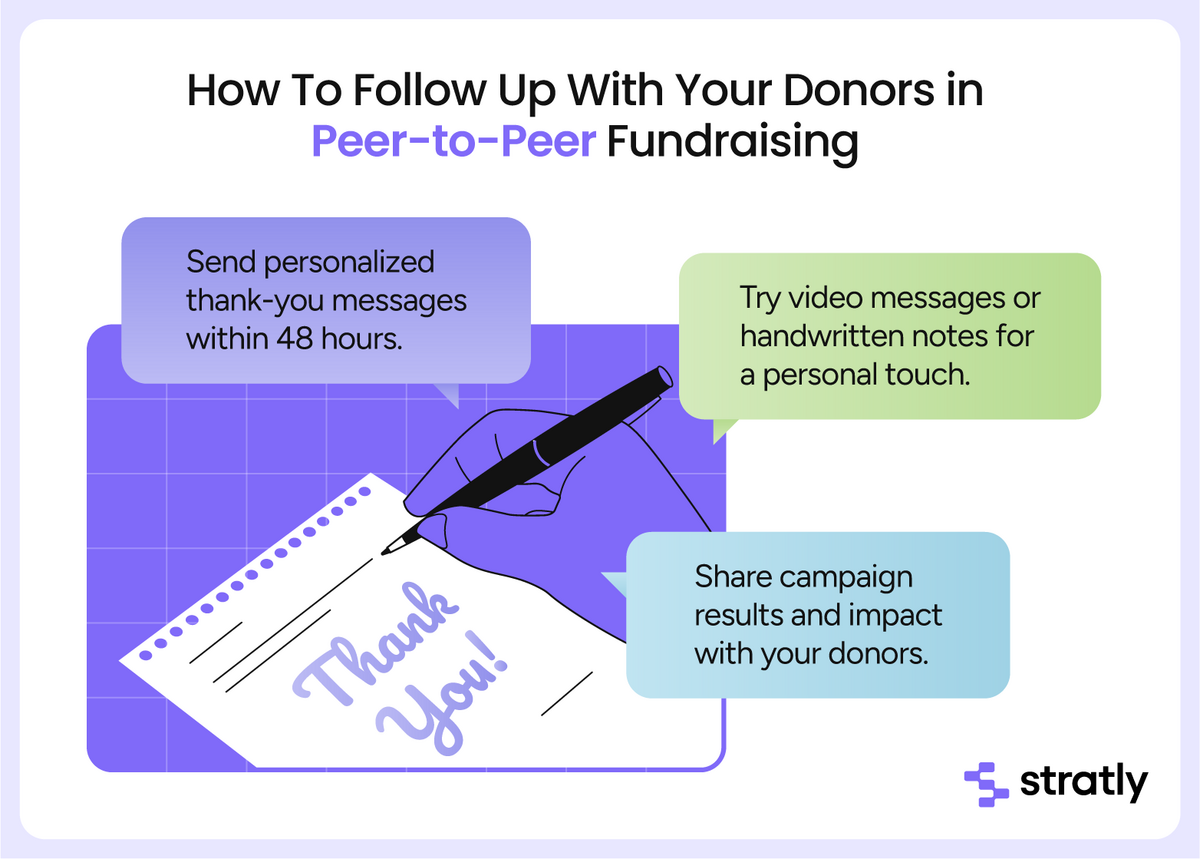
Thank Donors and Fundraisers Promptly
Within 48 hours, send personalized thank-you messages to those who donated or when a fundraiser hits a milestone. To add a personal touch, consider video messages or handwritten notes.
Share Campaign Results and Impact
At the campaign’s conclusion, provide a comprehensive report detailing:
- Total funds raised
- Number of donors and participating fundraisers
- Tangible outcomes achieved (e.g., meals served, animals rescued, etc.)
- Anecdotes or testimonials demonstrating the positive impact
Transparency like this fosters trust and shows donors the tangible results of their generosity.
Learn and Iterate
Every peer-to-peer campaign is an opportunity for growth. Take the time to examine your outcomes and gather feedback.
Conduct a Post-Campaign Analysis
Review essential metrics:
- Overall fundraising performance
- Success rates of individual fundraisers
- Donor acquisition and retention figures
- The effectiveness of various communication strategies
Use this data to identify what can be improved upon in future events.
Gather Feedback from Participants
Survey your fundraisers and donors to understand their experiences. Inquire about:
- Their motivation to participate
- The challenges they encountered during the campaign
- Suggestions for better fundraiser support
- Factors that would encourage repeat participation
This feedback is invaluable for refining your approach.
Peer-to-Peer Fundraising is the Key to Your Organization’s Success: Master the Basics and Enlist Support
Mastering peer-to-peer fundraising best practices is a continuous process. It demands a combination of meticulous planning, clear communication, and a genuine understanding of what drives your supporters.
By setting clear goals, equipping your fundraisers for success, utilizing the right technology, creating captivating stories, and maintaining consistent engagement, you’re well on your way to peer-to-peer fundraising success.
At its heart, peer-to-peer fundraising is about the connections we make.
Nurture those connections. Celebrate the impact of each contribution. Adapt your strategies based on feedback and results.
By integrating these peer-to-peer fundraising best practices, you can launch campaigns that reach your financial goals and cultivate a stronger, more engaged community dedicated to your cause.
Stratly is here to support. Schedule a demo today to experience our peer-to-peer fundraising tools firsthand!

